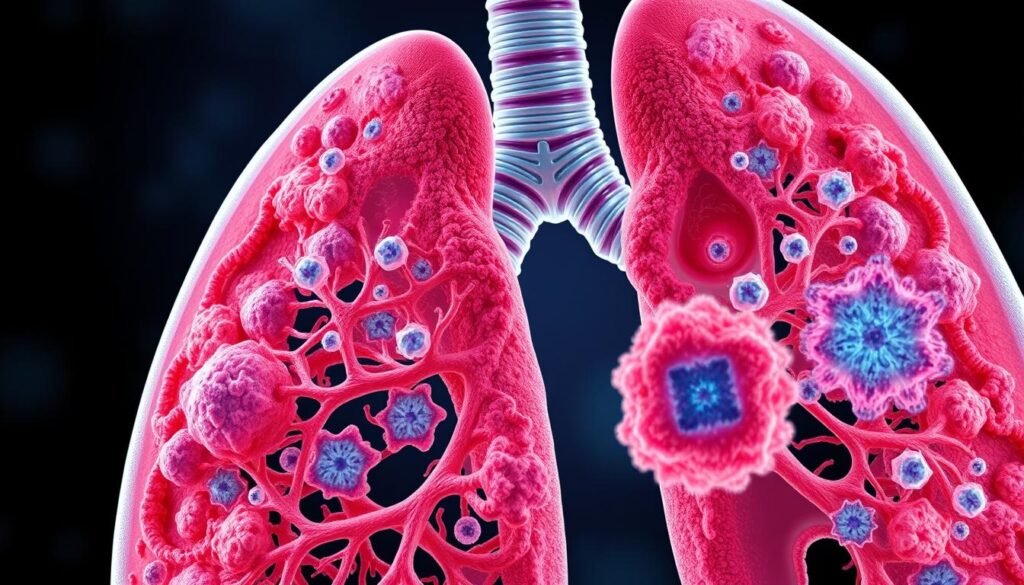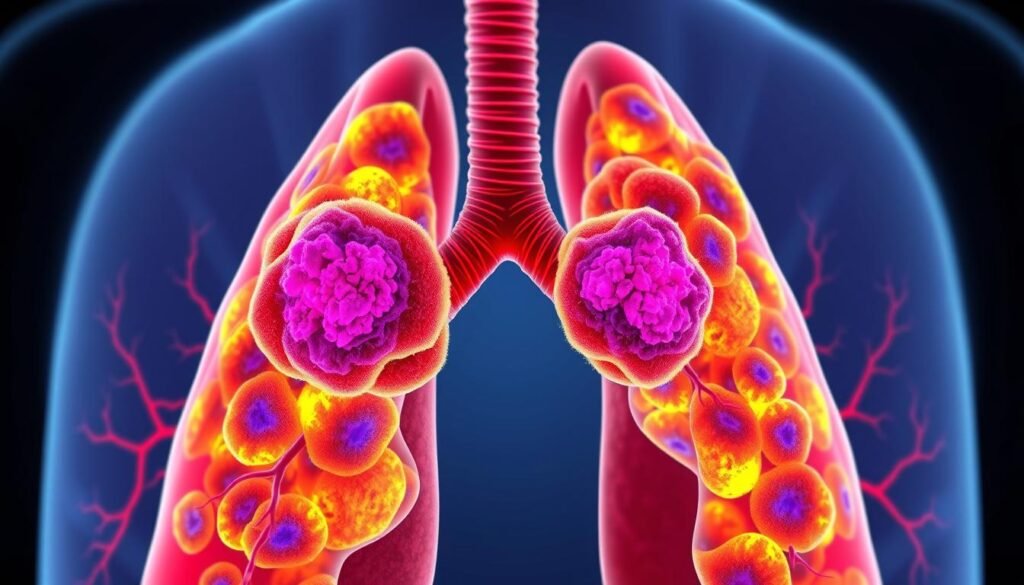Lung cancer touches about 225,000 Americans each year, ranking as the third most common cancer. While most know about non-small cell lung cancer (NSCLC) and small-cell lung cancer (SCLC), rare lung cancers are less understood. These include lung adenoid cystic carcinoma and pulmonary lymphoma.
Knowing about these rare types is key for the right diagnosis and treatment. This knowledge can help improve patients’ survival and life quality.
The range of lung cancer types is wide. It’s important to boost lung health awareness for the rarer types. Medical progress now allows for more personalized treatments, especially for rare cancers with specific genetic traits. For more information on rare lung cancers and their treatments, visit this resource.
Key Takeaways
- Lung cancer is the third most common cancer in the U.S., with approximately 225,000 cases yearly.
- Exploring rare lung cancers is critical for effective early diagnosis and personalized treatment approaches.
- Rare forms can profoundly affect patients, underscoring the need for continued awareness and research.
- Understanding specific genetic mutations can aid in tailoring treatment options for rare lung cancers.
- Lung health awareness is vital for improving outcomes and survival rates among lung cancer patients.
Introduction to Lung Cancer
Lung cancer is a major health problem worldwide. It’s the top cause of cancer deaths. The disease mainly splits into two types: small cell lung cancer (SCLC) and non-small cell lung cancer (NSCLC). Knowing about these helps us understand the symptoms and treatments.
Smoking is the biggest risk for lung cancer. It’s especially true for SCLC, seen mainly in heavy smokers. Being around secondhand smoke, radon, and asbestos also raises your risk. These factors can increase the chance of getting this serious disease.
- Chronic cough
- Weight loss without explanation
- Difficulty breathing
- Coughing up blood
- Persistent chest pain
Knowing these symptoms can lead to early detection. Early detection improves chances of beating lung cancer. Treatment depends on the type and stage of cancer. Surgery might work for early-stage NSCLC. RFA can help with tumors near the lung’s edge. There are more options like radiotherapy and chemotherapy.
| Treatment Modalities | Description |
|---|---|
| Surgery | For NSCLC that hasn’t metastasized, potential for complete removal of tumors. |
| Radiation Therapy | Utilized for NSCLC and SCLC; effective for shrinking tumors. |
| Chemotherapy | Combination of medications often administered via IV to target cancer cells. |
| Targeted Drug Therapy | Designed for specific mutations in NSCLC to inhibit cancer growth. |
| Immunotherapy | Boosts the immune response against cancer cells. |
| Palliative Care | Focuses on relieving symptoms such as pain and difficulty in breathing. |
Getting to know lung cancer helps people seek help early. It makes the treatment journey more understandable.
Common Types of Lung Cancer
Lung cancer is a big health issue. It comes in different types, affecting people in unique ways. The most common kind, non-small cell lung cancer (NSCLC), makes up about 80% to 85% of cases. NSCLC includes adenocarcinoma, squamous cell carcinoma, and large cell carcinoma. Each kind has its own traits and growth patterns.
Adenocarcinoma is the most common NSCLC type. It’s usually found in the outer lung areas. Interestingly, it’s more common in non-smokers. Squamous cell carcinoma, on the other hand, is often linked to smoking. It’s found mostly in the middle of the lungs and can be quite aggressive.
Large cell carcinoma is another NSCLC type that grows quickly and spreads fast. Knowing how fast they grow helps doctors decide on treatment.
Small cell lung cancer (SCLC) is less common but serious. It’s about 10% to 15% of lung cancer cases. SCLC is closely related to smoking and grows rapidly. NSCLC and SCLC highlight the importance of catching lung cancer early.
To choose the right treatment, it’s critical to understand these lung cancer types. For more info, check out lung cancer awareness guidelines.
| Type of Lung Cancer | Percentage of Cases | Characteristics |
|---|---|---|
| Non-Small Cell Lung Cancer | 80% to 85% | Includes adenocarcinoma, squamous cell carcinoma, large cell carcinoma |
| Adenocarcinoma | Most common NSCLC | Found in outer lung areas, more common in non-smokers |
| Squamous Cell Carcinoma | Type of NSCLC | Central location, linked to smoking |
| Large Cell Carcinoma | Type of NSCLC | Rapid growth and spread |
| Small Cell Lung Cancer | 15% to 20% | Almost always associated with smoking |
Understanding Non-Small Cell Lung Cancer
Non-small cell lung cancer (NSCLC) is found in about 85% of lung cancer cases. This category includes several kinds, with adenocarcinoma and squamous cell carcinoma being most common. These two types are the biggest part of NSCLC.
The types of non-small cell lung cancer are quite diverse. They include large cell carcinoma and others. Knowing these kinds helps doctors decide on the best treatment.
Treatment for NSCLC may include surgery, drugs, and other therapies. This is especially true when tests show certain genetic changes. For example, new treatments for lung adenocarcinoma involve specific mutations.
Finding symptoms early, like a lasting cough or chest pain, helps treat it better. Tests such as CT scans are crucial for diagnosis. The chance of success with treatment often depends on how early the cancer is found.
Types of Rare Lung Cancer
Rare types of lung cancer are not all that common. But they are very important to understand. This is because they have special features and hard treatment choices. Adenosquamous carcinoma is one such type. It has parts of both adenocarcinoma and squamous cell carcinoma. This makes it a tricky form of lung cancer to treat.
Sarcomatoid carcinoma stands out as another rare kind. It’s found in just 0.1 to 0.4 percent of all lung cancer cases. It’s known for being very aggressive and spreading quickly. Treating this disease is very challenging. There are also other rare types like large cell neuroendocrine carcinoma, mesothelioma, and various chest wall tumors.
Even though these diseases are not common, they are very different from other cancers. They need special research into targeted treatments. By learning about how they work and how to treat them, we can get better at caring for all lung cancer patients.
Other Rare Types of Lung Cancer
In the world of lung cancer, some types are rare. Understanding these rare cancers is important. They include salivary gland-type lung carcinoma, lung lymphoma, and granular cell tumors. These cancers are unique and pose challenges in diagnosis and treatment.
They are not like common cancers. Knowing how they are different is critical. We need special tools to identify them and specific plans to treat them.
Overview of Rare Types
Some lung cancers are not often found but still impact many. Adenosquamous carcinoma makes up about 0.4-4% of all lung cancer cases. Large cell neuroendocrine carcinoma is about 3%, and salivary gland-type lung carcinomas are very rare at 0.1-0.2%. Also, sarcomatoid carcinoma of the lung is seen in 0.3-3% of cases, while granular cell tumors are 0.2% of lung tumors.
Other types, like carcinoid tumors, are 1-6% of lung tumors. Most of these, 90%, are typical carcinoids. The rarer atypical carcinoids make up only 10%. Recognizing these cancers helps in finding better treatments and directing research.
Differences in Treatment and Prognosis
Treatment outcomes for these rare cancers vary widely from common lung cancers. For example, large cell neuroendocrine carcinoma has a 5-year survival rate of 27.4% to 35.3%. Salivary gland-type lung carcinomas show better prospects, with rates of 82% for 3 years, 70% for 5 years, and 63% for 10 years. But, sarcomatoid carcinoma patients have a 20% chance of living 5 years after diagnosis.
The table below sums up important facts about these rare lung cancers:
| Type of Lung Cancer | Percentage of Cases | 5-Year Survival Rate |
|---|---|---|
| Adenosquamous Carcinoma | 0.4-4% | Varies |
| Large Cell Neuroendocrine Carcinoma | 3% | 27.4% – 35.3% |
| Salivary Gland-Type Carcinoma | 0.1-0.2% | 70% (5-Year) |
| Sarcomatoid Carcinoma | 0.3-3% | 20% |
| Granular Cell Tumors | 0.2% | N/A |
| Carcinoid Tumors (Typical) | 1-6% | Varies |
Understanding rare lung cancers is crucial for patients, doctors, and researchers. Education and awareness about these cancers can lead to better care and outcomes. This knowledge will guide the future of cancer diagnosis and treatment strategies.
Lung Adenoid Cystic Carcinoma
Lung adenoid cystic carcinoma (ACC) is quite rare, making up about 0.04-0.2% of lung cancers. This cancer mainly appears in the central bronchi, unlike others found in segmental bronchi. Even though it’s considered low-grade, it can cause serious symptoms like trouble breathing and chest pain.
Characteristics and Symptoms
ACC grows slowly, which can delay its diagnosis. Often, by the time it’s found, it’s advanced. People with this cancer may face:
- Persistent cough
- Chest pain
- Shortness of breath
- Weight loss
To diagnose ACC, doctors use immunohistochemical tests. They look for cells positive for thyroid transcription factor 1 (TTF-1). This is crucial for identifying primary lung cancer, which TTF-1 can confirm in 60-70% of pulmonary adenocarcinomas.

Treatment Options
For ACC, surgery is the top treatment option. It’s the best way to manage this cancer. If the cancer can’t be entirely removed, adjuvant radiotherapy is important. It helps extend patients’ lives to match those with completely removed tumors. Chemotherapy and palliative radiotherapy usually don’t help much with advanced cancer, but surgery is critical for better outcomes.
Understanding ACC’s unique aspects is key to effective treatment plans. To learn more about lung cancer types, especially the differences between small cell and non-small cell lung cancer, you can go here.
Pulmonary Lymphoma
Pulmonary lymphoma is a rare lung cancer type, growing from lymphoid tissue. It falls into primary and secondary categories. The primary starts in the lungs and secondary comes from elsewhere in the body. Knowing both types helps with diagnosis and treatment.
Understanding the Condition
Primary pulmonary lymphoma is very uncommon. It’s 0.5% of lung cancers and less than 1% of all lymphomas. Around 70% to 90% of these are MALT lymphoma. Secondary pulmonary lymphoma is found more often and is harder to treat.
People are usually diagnosed around age 55, from ages 15 to 83. MALT lymphoma has a good survival rate of 87.1% over 5 years. Even as a rare cancer, pulmonary lymphoma’s outlook is better than other lung cancers.
Signs include cough, shortness of breath, chest pain, coughing blood, fever, and losing weight. Images may show lung nodules and opaque areas. A biopsy, with over an 80% success rate, helps diagnose accurately.
Chemotherapy is the main treatment, using CHOP or R-CHOP, among others. Sometimes, surgery also helps. Finding SPL tumors early can really help survival rates and management.
| Characteristic | Details |
|---|---|
| Incidence of PPL | 0.5% of primary lung cancers |
| Common Subtype | MALT lymphoma (70%–90% of PPL cases) |
| Typical Age of Diagnosis | 55 years (ranging from 15 to 83) |
| 5-Year Survival Rate for MALT | 87.1% |
| Treatment Approaches | Chemotherapy, surgical resection |
Knowing about pulmonary lymphoma’s traits and treatments is key to good management. It leads to better experiences and outcomes for patients.
Lung Carcinoid Tumors
Lung carcinoid tumors are rare neuroendocrine tumors found in the lungs. There are two main types: typical and atypical carcinoids. It’s vital to know the differences between them for proper diagnosis and treatment.
Types of Carcinoid Tumors
Typical carcinoids make up about 90% of these tumors. They grow slowly and rarely spread beyond the lungs. Meanwhile, atypical carcinoids, about 10% to 15% of cases, grow faster and can spread to nearby organs.
Most of these tumors are found in the central parts of the lungs, making up 80% of cases. Peripheral tumors are less common but significant. People around 50 years old often find out they have atypical carcinoids, showing early detection is key.
| Type of Carcinoid Tumor | Growth Rate | Metastasis Potential | Percentage of Cases |
|---|---|---|---|
| Typical Carcinoids | Slow | Rarely spreads | About 85% – 90% |
| Atypical Carcinoids | Faster | More likely to spread | 10% – 15% |
Pulmonary carcinoid tumors are very rare, making up less than 1% of all lung cancers. However, their numbers are rising. Symptoms like coughing, wheezing, and coughing up blood can occur. But 25% of people won’t have symptoms, leading to tumors being found by accident. Knowing about these tumors can help catch them early and treat them better.

Salivary Gland Type Lung Tumors
Salivary gland type lung tumors are quite rare, making up less than 1% of all lung cancers. They can be either mucoepidermoid cancer or adenoid cystic carcinoma. These tumors grow from the mucus-making glands in the airway. This makes them different from other types of lung cancer.
Adenoid cystic carcinomas (ACC) are usually bigger than mucoepidermoid carcinomas (MEC), with average sizes of 3.5 cm and 2.2 cm. Because of their size, ACC and MEC look different when doctors examine patients. Most ACC tumors are found in the central airways. In contrast, MEC tumors are often in the segmental bronchi.
Surgery is the main treatment option for these tumors. Sometimes, doctors also use other treatments depending on the tumor’s characteristics and the patient’s health. Factors like the tumor’s appearance on scans and whether it has spread to lymph nodes can affect a patient’s outlook. On average, patients with ACC live about 7.7 years after diagnosis, while those with MEC live around 4.0 years.
Even though these tumors are not common, it’s crucial to correctly identify and stage them. Missing tumor growth in the airways can lead to mistakes in staging. This highlights the need for detailed tissue studies and genetic testing to tell these tumors apart from other lung cancers.
| Feature | Adenoid Cystic Carcinoma | Mucoepidermoid Carcinoma |
|---|---|---|
| Mean Size | 3.5 cm | 2.2 cm |
| Prevalence in Central Airways | 94% | 63% |
| Median Overall Survival | 7.7 years | 4.0 years |
| 5-Year Survival Rate | 55% | 87% |
| 5-Year Survival Rate for Low-Grade Tumors | N/A | 95% |
| 5-Year Survival Rate for High-Grade Tumors | N/A | 75% |
Pulmonary Sarcomatoid Carcinoma
Pulmonary sarcomatoid carcinoma is a rare and aggressive lung cancer, making up about 0.1%–0.4% of all lung cancers. It often shows up late, with symptoms like shortness of breath, cough, coughing up blood, chest pain, and losing weight. The diagnosis usually comes one month after symptoms start. Imaging tests, like CT scans, show large tumors mostly in the lung’s upper part.

Presentation and Treatment
The treatment for this cancer varies in effectiveness. Surgery is key for those who can undergo it, leading to the longest survival—about 713.5 days. Adding chemotherapy to surgery helps too, extending life to 457.6 days on average.
Yet, chemotherapy alone doesn’t work as well for this tough cancer, offering a median survival of 256 days. This is still better than no treatment, which results in a survival of only about 205.5 days. Studies show combining chemotherapy with surgery offers hope, with some living about 516.8 days.
Despite the challenges, research continues. New treatments like immunotherapy, especially with immune checkpoint inhibitors, show promise for some patients. As we learn more, treatments targeting specific mutations could offer new hope for fighting pulmonary sarcomatoid carcinoma.
Conclusion
Understanding the details of rare lung cancers is key to better patient care. Lung cancer is the third most common cancer in the U.S. It’s also the leading cause of cancer deaths. Awareness about rare types of lung cancer is very important.
Rare lung cancers make up a small part of all cases. Yet, they pose big challenges in diagnosis and treatment. Special attention from doctors is crucial. Advances in diagnosing and understanding these cancers are making a difference. Thanks to research, we might see treatments that improve patient lives.
Personalized medicine is changing how we treat these uncommon lung cancers. It leads to better care strategies. Educating healthcare workers and supporting patients play a big role in facing lung cancer. Promoting early screening could improve survival rates.
Dealing with lung cancer’s impact on lives is tough. For more on diagnosing and treating these rare cancers, click here. It highlights the push for better treatments and understanding.